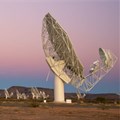Matjiesfontein, a small town in the Central Karoo, will house Nasa’s new lunar communication facility being built in partnership with the South African National Space Agency. Once operational, it will help the Artemis mission put the first woman on the moon in 2025.
This initiative forms part of South Africa's newly launched national astro-tourism strategy.
Spearheaded by the Department of Tourism in collaboration with the Department of Science and Innovation, it seeks to capitalise on the presence of key astronomical facilities in South Africa and aims to position the country as a leading astro-tourism destination.
While Prince Albert and the Cederberg are among those already positioned as astro-tourism destinations, the national strategy aims to incorporate The Northern Cape and Matjiesfontein as the focal point of this strategy. This will likely involve a variety of initiatives such as tour guides, stargazing events, public talks and facility visits to engage and educate visitors.
These visits will educate tourists about the scientific research being conducted there and the global significance of these observatories.
“Astro-tourism has been gaining recognition globally as a unique and exciting form of tourism. It is positive for the destination to see that the national Department of Tourism is aiming to harness its potential by developing a strategic framework to drive the industry forward,” said Monika Luel, chief tourism officer at Wesgro.
Boosting lunar tourism
A development such as the one in Matjiesfontein offers considerable advantages for boosting tourism. To this end, Matjiesfontein will host one of three Lunar Exploration Ground Sites (Legs), with large antennae ranging from 18m to 24m in diameter. These antennae will enable near-continuous communication between the Artemis spacecraft and future lunar explorers.
The strategic location in South Africa, along with two other ground stations in New Mexico and Australia, ensures the moon is always in view from at least one station, crucial for maintaining direct-to-Earth communication over vast distances.
This continuous communication will support both the exploration of the moon and long-term missions that will serve as stepping stones to Mars.
The facility also relieves pressure on Nasa's existing Deep Space Network, which is already heavily used for numerous space missions.
The national astro-tourism plan will also highlight the following key astronomical facilities:
Sutherland, about 150km from Prince Albert: The South African Astronomical Observatory (SAAO)Home to Salt, the largest single optical telescope in the Southern Hemisphere. It is used primarily for visible light observations of distant galaxies, stars, and other celestial bodies, making it ideal for studying phenomena such as the structure of the universe and supernovae.Cederberg: The Cederberg Astronomical Observatory, located near ClanwilliamA private, non-profit observatory, the CAO has several telescopes, including a 16-inch Meade LX200 GPS Schmidt-Cassegrain telescope and various smaller instruments for deep-sky observations of planets, stars, nebulae, and galaxies.The observatory offers guided tours and viewing sessions for the public, particularly on weekends. These events typically include stargazing, where visitors can observe celestial objects under expert guidance.Northern Cape: MeerKAT, and the Square Kilometre Array (SKA)MeerKAT is a precursor to the SKA and is a highly sensitive radio telescope array. It detects radio waves from space, which helps astronomers study cosmic phenomena like black holes, galaxies, and the early universe.Under construction, SKA is an international project aiming to build the world's largest radio telescope array, capable of exploring the cosmos in unprecedented detail. It will work in conjunction with MeerKAT and expand on its capabilities to map the universe, study dark matter, and investigate the origins of life. Harnessing dark skies
The launch of this national astro-tourism initiative represents South Africa's broader ambition to leverage its astronomical assets and unique Southern Hemisphere vantage point for both scientific progress and tourism development.
It aligns with the Office of Astronomy for Development’s programme, which focuses on sustainable, local, and socio-economic development through astronomy.
The flagship initiative explores how astronomy can serve as a catalyst for socio-economic progress, with astro-tourism being one of its key projects. The mission of this project is to empower rural communities to leverage their dark skies and rich cultural and natural heritage to enhance local economic growth.
“[Attractions like these] will benefit the tourism value chain as it will bring visitors into the area to experience the astro-tourism offerings and spend the night or weekend, which ultimately leads to consumption of surrounding hospitality and tourism offerings – not just hotels but farm stays, restaurants and even our much-loved padstals selling local produce," said Luel.
“This type of project will most definitely have an impact on tourism and we are excited to watch it unfold."




































